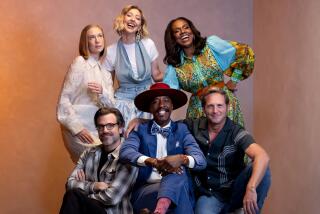The Golden Era of Comedy : ROMANTIC COMEDY <i> by James Harvey (Knopf: $35; 716 pp., illustrated) </i>
- Share via
A new kind of comedy began coming out of the Hollywood studios in the 1930s, writes the author of this massive and admirable study--a comedy not only funny but exhilarating, one that moved toward a “union between rapture and skepticism,” where laughter equaled intimacy: “a deep involuntary motion of the spirit.”
James Harvey, a playwright and critic who teaches at State University of New York, Stony Brook, illustrates how the romantic film comedy of that era was an outgrowth of the “classy” comedy, like Noel Coward’s “Private Lives,” and the “tough” comedy of Ben Hecht and Charles MacArthur’s “The Front Page.”
The high life and smart talk of the former combined with the low life and rough talk of the latter to produce the “screwball” comedy, a filmic dish that had Continental seasoning but was decidedly indigenous to America. This kooky souffle was as breezy and elusive as a cloud, and no less a movie reviewer than Graham Greene declared its essence impossible to describe in mere prose.
Yet describe is one of the principal things Harvey does here--obsessively, in minute detail and, for the most part, wonderfully.
The two supreme masters of the screwball form, by Harvey’s lights, were Ernst Lubitsch and Preston Sturges. The works and careers of those two directors are scrutinized over nearly half the book. The definitive screwball comedy, though, “the purest of all such films,” Harvey thinks, was Leo McCarey’s “The Awful Truth” (1937). William Powell and Myrna Loy, teamed in the “Thin Man” series and elsewhere, are called “the quintessential ‘30s couple.” And Harvey deems Irene Dunne “the most dazzling screwball comedienne of them all.”
Harvey is a tireless enthusiast, almost in competition with himself in coining superlatives for players like Jean Harlow (“a vision at once tacky and awesome”), Carole Lombard (“craziness as a kind of transcendence”) and Rosalind Russell (“It’s not grace she aspires to but composure . . . turning well-being into a peak experience”). The nuances of given performances are analyzed almost frame by frame, with this technique reaching some sort of apogee in a discussion of a dance routine by Ginger Rogers and Fred Astaire (“his sunny, almost Mozartean art”) in which strips of film enlargements run down the page borders in visual supplement to the author’s high-stepping prose. (Excepting these clips from “Follow the Fleet” (1936), the book’s generous and handsome illustrations are all crisply reproduced production stills.)
Harvey’s appreciative critical essays of such stars and directors as Cary Grant and Claudette Colbert, George Stevens and Howard Hawks, are consistently informed, illuminating and entertaining. They are full of apt and amusing insights--as when Harvey writes that “Lubitsch’s favorite kind of joke (is) the kind that implicates the one who laughs. . . .” Describing Jean Arthur and Gary Cooper in “The Plainsman” (1936): “Tied by their wrists to a pole inside a tepee, straining toward each other while hostile redskins whoop it up outside. The DeMille touch.” Spelling out the dilemma of leading lady Arthur in director Frank Capra’s non-screwball films, where she “can’t bring herself to believe that someone as simple as (Mr.) Deeds or (Mr.) Smith . . . isn’t either a fake or an imbecile. In a screwball comedy . . . he would, in fact, very likely be both . . . and would be played by Ralph Bellamy.” Observing that Howard Hawks’ “Rio Bravo” (1959) understands friendship as “a nuisance that makes people glamorous.”
“Rio Bravo,” you ask, in a treatise on screwball? Well, it really does seem to belong, meandering logically out of a discussion of the career of the director who fashioned the classic “His Girl Friday” (1940).
Given the space and freedom provided Harvey by himself and his publisher, there’s room for all sorts of digression--a brief bow to “Gone With the Wind” (1939) as “a kind of ultimate tough comedy,” for instance; as well as fascinated scrutinies of such bizarre missteps as McCarey’s “My Son John” (1952) (“the whole film has a raving, disconnected quality--even . . . its most casual exchanges”), Sturges’ “The Great Moment” (1944) (“When had anyone pulled anything like this? . . . The depression and misanthropy are almost too palpable. . . .”) and Lubitsch’s “The Man I Killed” (1932) (“a monstrous, miscalculated . . . film (that) gives everyone the creeps. . .”).
A book this exhaustive can be exhausting. And every once in a while that analytical prose seems a bit inappropriate to the subject--like a mad architect’s painstaking blueprint for a cream puff, or a computer graphic of the geological coordinates of cocoa foam. But long as it is, the book isn’t padded--it’s simply supremely comprehensive. And to a great degree, Harvey succeeds in pressing these fleeting and ineffable moments he loves onto the printed page. His tribute to the screwball form seems richly deserved and terrifically realized. And it does something all such tributes should do: makes you want to go look at a lot of old movies.
More to Read
The biggest entertainment stories
Get our big stories about Hollywood, film, television, music, arts, culture and more right in your inbox as soon as they publish.
You may occasionally receive promotional content from the Los Angeles Times.










